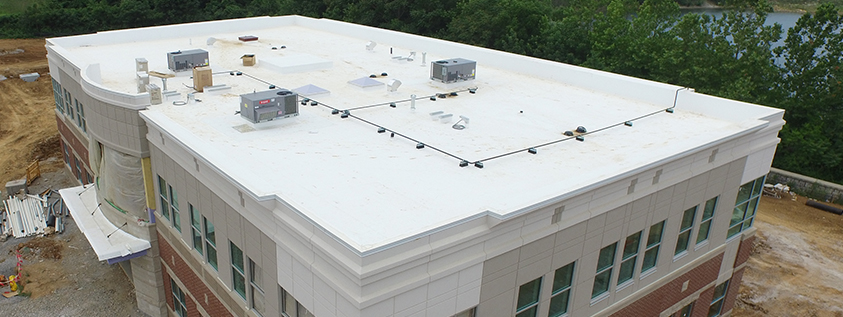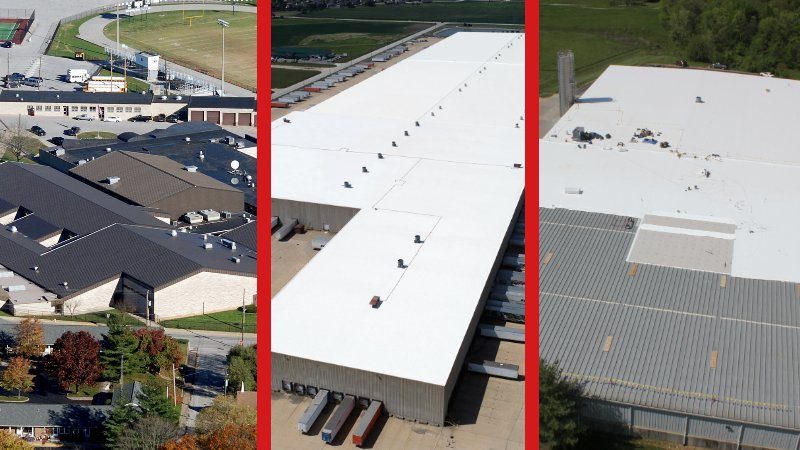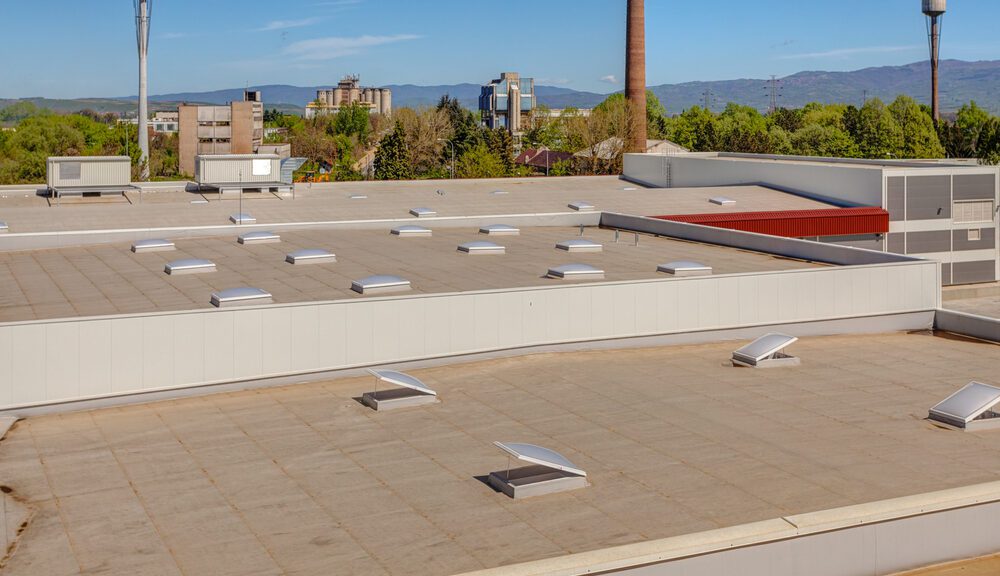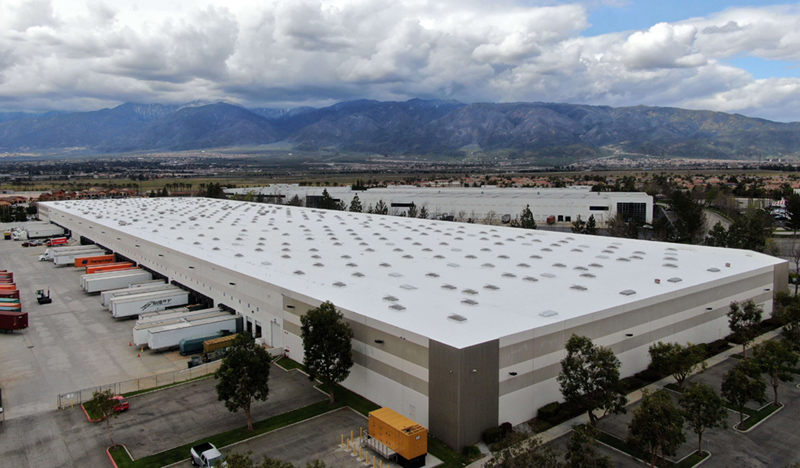When it comes to choosing the right roof for a commercial building, there are numerous factors to consider. From weather resistance and durability to cost-effectiveness and aesthetics, finding the perfect roof can seem like a daunting task. In this article, we will explore the different types of roofs commonly used in commercial buildings, highlighting their benefits and drawbacks. By the end, you will have a comprehensive understanding of the various choices available, empowering you to make an informed decision for your commercial property.

Overview of Commercial Roofing
When it comes to commercial buildings, choosing the right roofing type is of utmost importance. The roof is not only responsible for protecting the structure from external elements, but it also plays a crucial role in energy efficiency, aesthetics, and overall functionality. Therefore, it is crucial to consider various factors before deciding on the type of roofing for your commercial building. In this comprehensive article, we will explore the different types of commercial roofing, including their advantages and disadvantages, to help you make an informed decision.
Importance of Choosing the Right Roofing Type
Choosing the right roofing type for your commercial building is essential for several reasons. Firstly, the type of roof you select will impact the overall longevity and durability of the structure. A well-chosen roof can withstand harsh weather conditions, such as heavy rain, strong winds, or even extreme temperatures. Secondly, the right roofing type can enhance the energy efficiency of your building. A poorly insulated or inefficient roofing system can lead to high heating and cooling costs, impacting your bottom line. Lastly, choosing the right roofing type can significantly impact the aesthetics of your commercial building, creating a positive first impression for your clients and visitors.

Factors to Consider for Commercial Roofing
Before diving into the different types of commercial roofing, it is important to consider several factors that will influence your selection. Firstly, you need to analyze the climate and weather conditions of your region. Some roofing types are better suited for specific climates, while others may not perform as well. Additionally, you should consider the slope or pitch of your roof, as this will determine which roofing options are suitable. The size and layout of your commercial building, as well as your budget and maintenance requirements, should also be taken into account. By carefully considering these factors, you can make an informed decision that aligns with your needs and preferences.
Different Types of Commercial Roofing
Commercial roofing offers a variety of options to choose from. Each type possesses its unique advantages and disadvantages, so let’s delve into the most popular ones to help you understand which may be the best fit for your commercial building.

Flat Roofs
Advantages of Flat Roofs
Flat roofs are a popular choice for commercial buildings due to their affordability and ease of installation. One of the key advantages of flat roofs is the additional space they provide for HVAC units, solar panels, or even rooftop gardens. The design of flat roofs also allows for easy maintenance and routine inspections. In addition, they are relatively safer for workers to access for maintenance purposes. Flat roofs can also be more cost-effective when it comes to repairs and replacement, as the materials used are generally more accessible and less expensive.
Disadvantages of Flat Roofs
Despite their advantages, flat roofs also have some drawbacks that should be considered. One of the main concerns is drainage. Flat roofs tend to accumulate water, which can lead to leaks if not properly maintained. Constant monitoring and regular maintenance are necessary to avoid these issues. Additionally, flat roofs may not be as aesthetically pleasing as other options, especially if you value a more traditional or architectural look for your commercial building.
Types of Flat Roofs
Various materials can be used for flat roofs, including built-up roofing (BUR), modified bitumen, and single-ply membranes such as EPDM (Ethylene Propylene Diene Monomer) or TPO (Thermoplastic Olefin). Each material offers its unique advantages and considerations, catering to different budget and performance requirements.
Pitched Roofs
Advantages of Pitched Roofs
Pitched roofs, characterized by their sloping design, offer their own set of advantages for commercial buildings. One of the key advantages is improved drainage. With the inclined surface, rainwater and snow can quickly run off, reducing the risk of leaks or weight accumulation on the roof. Pitched roofs also provide additional space under the roof where mechanical equipment or storage can be located. Additionally, the architectural appeal of pitched roofs can enhance the visual aesthetics of your commercial building, making it stand out and potentially attracting more customers.
Disadvantages of Pitched Roofs
While pitched roofs offer several advantages, there are also some disadvantages to consider. The complexity of the design and installation process can make pitched roofs more expensive compared to other options. The steeper pitch also poses challenges for maintenance and regular inspections. Moreover, the additional space under the roof may not be fully utilized in all commercial buildings, making it a less crucial factor for some owners.
Types of Pitched Roofs
Pitched roofs can be constructed using various materials, such as asphalt shingles, wood shingles, clay or concrete tiles, or metal panels. Each material offers different aesthetics, durability, and cost considerations, allowing you to choose the option that best fits your commercial building’s requirements.

Metal Roofs
Advantages of Metal Roofs
Metal roofs are becoming increasingly popular in commercial buildings due to their durability, longevity, and exceptional resistance to extreme weather conditions. Metal roofs are fire-resistant, making them a safer option for your commercial building. They also offer excellent energy efficiency, as they reflect sunlight, reducing the heat absorbed by the building and lowering cooling costs. Metal roofs can be installed quickly, saving both time and money during the construction process.
Disadvantages of Metal Roofs
One of the main disadvantages of metal roofs is their initial cost. Metal roof materials tend to be more expensive than other roofing options. However, it is important to consider the long-term benefits and cost savings that metal roofs provide. Some may also perceive metal roofs as less aesthetically pleasing, although modern designs and finishes have significantly improved their visual appeal.
Types of Metal Roofs
Metal roofs come in various materials, including steel, aluminum, copper, and zinc. Each material has its unique properties and aesthetics, allowing you to choose the option that best aligns with your commercial building’s requirements and budget.
Shingle Roofs
Advantages of Shingle Roofs
Shingle roofs, typically made from asphalt, are a popular and cost-effective choice for many commercial buildings. The installation process is relatively simple and quick, reducing labor costs. Shingle roofs also provide good insulation, enhancing energy efficiency and reducing heating and cooling costs. Additionally, shingles come in a wide range of color options, allowing you to customize the appearance of your commercial building.
Disadvantages of Shingle Roofs
Shingle roofs have their own set of considerations. They are not as durable as some other roofing options, potentially requiring more frequent repairs and replacement. Shingles can be susceptible to damage from severe weather conditions, such as strong winds or hail. Moreover, the lifespan of shingle roofs may vary depending on the quality of materials used.
Types of Shingle Roofs
Asphalt shingles are the most common type of shingle roofs for commercial buildings. However, there are also various options available within the asphalt shingle category, such as architectural shingles or three-tab shingles. Each type offers different aesthetics and performance characteristics, providing flexibility for your commercial roofing needs.

Tile Roofs
Advantages of Tile Roofs
Tile roofs, often made from clay or concrete, offer a unique and elegant appearance for commercial buildings. They are highly durable and can last for decades with proper maintenance. Tile roofs provide excellent fire resistance, making them a safe option for your commercial building. The natural materials used in tile roofs also make them environmentally friendly. Moreover, tile roofs offer great insulation properties, reducing energy consumption and costs.
Disadvantages of Tile Roofs
One of the main disadvantages of tile roofs is their weight. They are significantly heavier than other roofing materials, requiring additional structural support during installation. This can increase the overall construction costs. Tile roofs also tend to be more expensive compared to other options. Additionally, the fragility of tiles makes them susceptible to damage from impacts, such as falling branches or hail.
Types of Tile Roofs
Tile roofs can be made from clay or concrete. Each material offers its own aesthetic options, durability, and cost considerations. With a wide range of shapes, colors, and finishes available, tile roofs can provide a unique and appealing look for your commercial building.
Thermoplastic Roofing (TPO)
Advantages of TPO Roofs
TPO roofs, made from a blend of polypropylene and ethylene-propylene rubber, offer numerous advantages for commercial buildings. They are highly resistant to UV rays, chemicals, and punctures, ensuring superior durability. TPO roofs are also energy-efficient, reflecting heat and reducing the need for excessive cooling. The white or light-colored membranes of TPO roofs contribute to a cooler building interior, further enhancing energy savings. Moreover, TPO roofs are lightweight, making them easier to install and requiring less structural support.
Disadvantages of TPO Roofs
One of the main concerns with TPO roofs is their relatively shorter lifespan compared to some other roofing options. While TPO roofs can provide reliable performance for approximately 15-20 years, their longevity may not match that of metal or tile roofs. Additionally, the quality and thickness of the TPO membrane can vary, affecting its performance and durability. Careful consideration and proper installation by an experienced contractor are key to ensuring the longevity of TPO roofs.
Other Considerations for TPO Roofs
TPO roofs can be installed using various methods, such as mechanically attached, fully adhered, or ballasted. The installation technique should be selected based on factors like wind uplift resistance, building plans, and budget. It is crucial to work with a reputable roofing contractor experienced in TPO installations to ensure proper installation and maintenance.
EPDM (Ethylene Propylene Diene Monomer) Roofing
Advantages of EPDM Roofs
EPDM roofs, commonly known as rubber roofs, offer several advantages for commercial buildings. One of the key advantages is their exceptional durability. EPDM roofs can last for over 40 years with proper maintenance, making them a long-term investment. They are highly resistant to UV radiation, ozone, and harsh weather conditions, ensuring reliable performance. EPDM roofs also provide good insulation properties, reducing energy consumption and costs. Additionally, EPDM roofs are relatively simple to install, requiring fewer seams and minimizing the risk of leaks.
Disadvantages of EPDM Roofs
One of the main disadvantages of EPDM roofs is their dark color, which can contribute to heat absorption and potentially increase cooling costs. However, reflective or white coatings can be applied to mitigate this issue. Another consideration is the installation process, which requires precise and careful techniques to ensure proper adhesion and seam integrity.
Installation and Maintenance of EPDM Roofs
Proper installation of EPDM roofs is crucial to ensure their longevity and performance. It is recommended to work with an experienced roofing contractor who specializes in EPDM installations. Regular inspections and maintenance, including cleaning and repairing any damages, are essential to maximize the lifespan of EPDM roofs.
Green Roofs
Advantages of Green Roofs
Green roofs, also known as living roofs or eco-roofs, provide a sustainable and environmentally friendly option for commercial buildings. They feature a layer of vegetation, creating an additional natural habitat, improving air quality, and reducing the urban heat island effect. Green roofs also offer excellent insulation properties, reducing energy consumption and costs. Moreover, they can extend the overall lifespan of the roof membrane by protecting it from UV radiation and extreme weather conditions.
Disadvantages of Green Roofs
One of the main disadvantages of green roofs is their higher initial cost compared to traditional roofing options. The installation process is more complex, requiring additional layers and waterproofing systems. Moreover, regular maintenance is necessary to ensure the health and vitality of the vegetation, including irrigation, fertilization, and weed control. Additionally, the structural integrity of the building must be carefully evaluated to ensure it can support the weight of the green roof.
Types of Green Roofs
There are two main types of green roofs: intensive and extensive. Intensive green roofs feature a thicker layer of soil, allowing for a wider range of plantings, including trees and shrubs. They require more maintenance and are typically used in larger commercial buildings. Extensive green roofs have a shallower layer of soil and are planted with low-maintenance vegetation, such as sedums or grasses. They require less maintenance and are commonly used in smaller commercial buildings or structures with weight restrictions.
Choosing the Right Roofing Contractor
Once you have determined the best type of roofing for your commercial building, it is crucial to select a reputable and experienced roofing contractor to ensure a successful installation. Consider the following factors when choosing a roofing contractor:
Research and References
Do thorough research and gather recommendations from trusted sources, such as friends, colleagues, or industry professionals. Read customer reviews and testimonials to assess the contractor’s reputation and track record. Engage in detailed discussions with potential contractors to ensure they understand your specific needs and can provide the desired roofing solution.
Licensure and Insurance
Verify that the roofing contractor holds the necessary licenses and certifications required by your local jurisdiction. A licensed contractor demonstrates compliance with industry standards and regulations. Additionally, ensure that the contractor has appropriate liability insurance and workers’ compensation coverage to protect both your property and their employees in case of accidents or damages.
Experience and Expertise
Choose a roofing contractor with extensive experience in commercial roofing and a proven track record of successful installations for similar projects. Experienced contractors possess the knowledge and expertise to assess your building’s unique requirements, recommend the most suitable roofing solution, and ensure high-quality workmanship.
By considering these factors and prioritizing the selection of a reputable roofing contractor, you can confidently proceed with your commercial roofing project, knowing that it is in capable hands.
In conclusion, the type of roof you choose for your commercial building can significantly impact its functionality, energy efficiency, durability, and overall aesthetics. By carefully considering the advantages and disadvantages of various roofing options, understanding your building’s specific needs and requirements, and selecting a reputable roofing contractor, you can make an informed decision and ensure a successful roofing project. Choose wisely and enjoy the benefits of a well-protected and visually appealing commercial building.